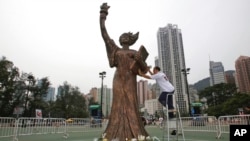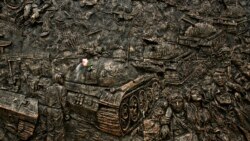Another two Hong Kong universities removed public artwork Friday commemorating China’s 1989 crackdown on pro-democracy protesters in Beijing’s Tiananmen Square.
The Goddess of Democracy statue was taken away before dawn from the Chinese University of Hong Kong.
The statue, depicting a woman holding a flame high, was created by Chen Weiming and resembled the original, which was made mostly of papier-mache and erected in Tiananmen Square during the protests.
In a statement, the university said the statue was unauthorized.
"Following an internal assessment, and as the manager of the university campus, CUHK has removed the statue," the statement said.
A relief sculpture depicting the Tiananmen massacre also disappeared Friday from a wall at Lingnan University.
On Thursday, a leading Hong Kong university dismantled and removed a statue commemorating the crackdown from campus.
Students and onlookers gathered Thursday morning at the University of Hong Kong to contemplate the removal of a statue that stood on the campus for more than two decades.
University officials say the statue has been placed in storage.
The Council of HKU said in an early Thursday statement it made the decision to remove the statue during a Wednesday meeting, "based on external legal advice and risk assessment for the best interest of the university."
The artwork of anguished human torsos is one of the few remaining public memorials in the former British colony to mark the bloody crackdown, which is a taboo topic in mainland China, where it cannot be publicly commemorated.
Known as the Pillar of Shame, the statue was a key symbol of the wide-ranging freedoms promised to Hong Kong at its 1997 return to Chinese rule.
The sculptor, Jens Galschiot, told VOA he tried to negotiate with authorities to remove the statue intact so it could be taken to his native Denmark but was ignored.
He called the act “brutal” and said it was “destroying art,” and he lamented that Hong Kong is “getting more and more like China.”
China has never provided a full account of the 1989 Tiananmen Square crackdown. Officials gave a death toll of about 300, but rights groups and witnesses say thousands may have been killed.
Authorities have been clamping down in Hong Kong under a China-imposed national security law that human rights activists say is being used to suppress civil society, jail democracy campaigners and curb basic freedoms.
Authorities say the law has restored order and stability after massive street protests in 2019. They insist freedom of speech and other rights remain intact and that prosecutions are not political.
The VOA Mandarin Service contributed to this report.





